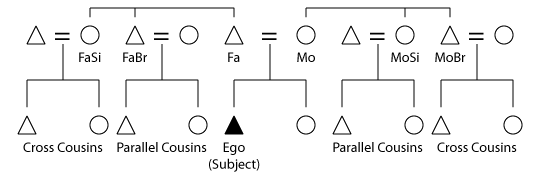|
Cross-cousin
In discussing consanguineal kinship in anthropology, a parallel cousin or ortho-cousin is a cousin from a parent's same-sex sibling, while a cross-cousin is from a parent's opposite-sex sibling. Thus, a parallel cousin is the child of the father's brother (paternal uncle's child) or of the mother's sister (maternal aunt's child), while a cross-cousin is the child of the mother's brother (maternal uncle's child) or of the father's sister (paternal aunt's child). Where there are unilineal descent groups in a society (i.e. matrilineal and/or patrilineal), one's parallel cousins on one or both sides will belong to one's own descent group, while cross-cousins will not (assuming descent group exogamy). Role The role of cross-cousins is especially important in some cultures. For example, marriage is promoted between them in the Iroquois system. Parallel cousins are occasionally the subject of promoted marriage, such as the preferential marriage of a male to his father's brother's da ... [...More Info...] [...Related Items...] OR: [Wikipedia] [Google] [Baidu] [Amazon] |
Cousin Marriage
A cousin marriage is a marriage where the spouses are cousins (i.e. people with common grandparents or people who share other fairly recent ancestors). The practice was common in earlier times and continues to be common in some societies today. In some jurisdictions such marriages are prohibited due to concerns about inbreeding. Worldwide, more than 10% of marriages are between first or second cousins. Cousin marriage is an important topic in anthropology and alliance theory. In some cultures and communities, cousin marriages are considered ideal and are actively encouraged and expected; in others, they are seen as incestuous and are subject to social stigma and taboo. Other societies may take a neutral view of the practice, neither encouraging nor condemning it, though it is usually not considered the norm. Cousin marriage was historically practiced by indigenous cultures in Indigenous Australians, Australia, Indigenous peoples of the Americas#North America, North America, Indig ... [...More Info...] [...Related Items...] OR: [Wikipedia] [Google] [Baidu] [Amazon] |
Iroquois Kinship
Iroquois kinship (also known as bifurcate merging) is a kinship system named after the Haudenosaunee people, also known as the ''Iroquois'', whose kinship system was the first one described to use this particular type of system. Identified by Lewis Henry Morgan in his 1871 work '' Systems of Consanguinity and Affinity of the Human Family'', the Iroquois system is one of the six major kinship systems (Eskimo, Hawaiian, Iroquois, Crow, Omaha, and Sudanese). Kinship system The system has both classificatory and descriptive terms. In addition to gender and generation, Iroquois kinship also distinguishes 'same-sex' and 'cross-sex' parental siblings: the brothers of Ego's (the subject from whose perspective the kinship is based) father, and the sisters of Ego's mother, are referred to by the same parental kinship terms used for Ego's Father and Mother. The sisters of Ego's father, and the brothers of Ego's mother, on the other hand, are referred to by non-parental kinship terms, ... [...More Info...] [...Related Items...] OR: [Wikipedia] [Google] [Baidu] [Amazon] |
Kinship Terminology
Kinship terminology is the system used in languages to refer to the persons to whom an individual is related through kinship. Different societies classify kinship relations differently and therefore use different systems of kinship terminology; for example, some languages distinguish between consanguine and Affinal kin, affinal uncles (i.e. the brothers of one's parents and the husbands of the sisters of one's parents, respectively), whereas others have only one word to refer to both a father and his brothers. Kinship terminologies include the terms of address used in different languages or communities for different relatives and the terms of reference used to identify the relationship of these relatives to ego or to each other. Historical view Anthropologist Lewis H. Morgan, Lewis Henry Morgan (1818–1881) performed the first survey of kinship terminologies in use around the world. Though much of his work is now considered dated, he argued that kinship terminologies reflect di ... [...More Info...] [...Related Items...] OR: [Wikipedia] [Google] [Baidu] [Amazon] |
Omaha Kinship
Omaha kinship is the system of terms and relationships used to define family in Omaha tribal culture. Identified by Lewis Henry Morgan in his 1871 work ''Systems of Consanguinity and Affinity of the Human Family'', the Omaha system is one of the six major kinship systems (Eskimo, Hawaiian, Iroquois, Crow, Omaha, and Sudanese) which he identified internationally. Kinship system In function, the system is extremely similar to the Crow system. But, whereas Crow groups are matrilineal, Omaha descent groups are characteristically patrilineal. In this system, relatives are sorted according to their descent and their gender. Ego's father and his brothers are merged and addressed by a single term, and a similar pattern is seen for Ego's mother and her sisters. (Marriages take place among people of different ''gentes'' or clans in the tribe.) Like most other kinship systems, Omaha kinship distinguishes between parallel and cross-cousins. While parallel cousins are merged by term and a ... [...More Info...] [...Related Items...] OR: [Wikipedia] [Google] [Baidu] [Amazon] |
Cousin
A cousin is a relative who is the child of a parent's sibling; this is more specifically referred to as a first cousin. A parent of a first cousin is an aunt or uncle. More generally, in the kinship system used in the English-speaking world, cousins are in a type of relationship in which the two cousins are two or more generations away from their most recent common ancestor. In this usage, "degrees" and "removals" are used to specify the relationship more precisely. "Degree" measures how distant the relationship is from the most recent common ancestor(s), starting with one for first cousins and increasing with every subsequent generation. If the cousins do not come from the same generation, "removal" expresses the difference in generations between the two cousins. When no removal is not specified, no removal is assumed. Various governmental entities have established systems for legal use that can precisely specify kinship with common ancestors any number of generations i ... [...More Info...] [...Related Items...] OR: [Wikipedia] [Google] [Baidu] [Amazon] |
